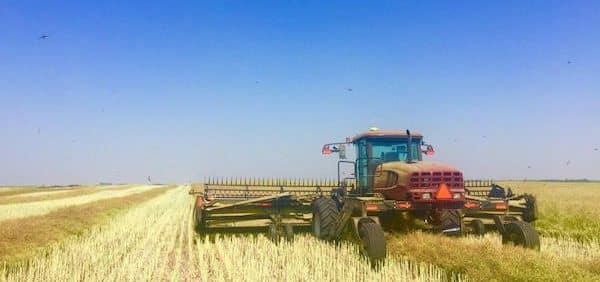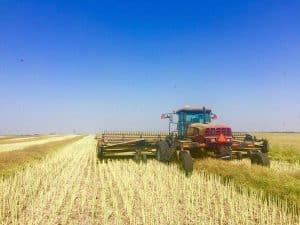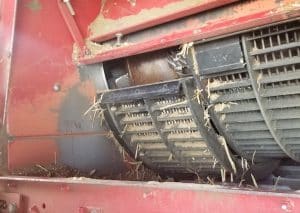1.How can I harvest sooner? Swathed canola can be ready to combine earlier than standing canola, but swathing early does not necessarily mean combining early. Canola swathed green takes a lot longer to cure than canola swathed at 60% seed colour change, and by cutting early, the crop may not meet its yield and quality potential. For canola left standing for straight combining, desiccants (diquat/Reglone) will not speed-up crop maturity, but they can speed up crop dry-down and make it possible to get into the field sooner. Note the important distinction: There is a big difference between maturity and dry-down. Desiccants like diquat shut down the plant and basically STOP it from maturing, which can lock in high green seed levels and end the finishing opportunity for latest seeds if applied prematurely. READ MORE
2. How early can I swath? The best time to swath for yield and quality is when 50-60% of seeds on the main stem are starting to turn colour. Seeds that are not ‘firm to roll’ may not mature at all. If swathing with only 30% SCC on the main stem, a lot of seeds in the side branches may be at the too-early stage. That means lost yield. See the swath timing section of the Canola Harvest Guide. READ MORE
3. When is canola ready to straight combine? To determine when a canola crop is ‘ready’ to be straight combined, stalk dry down, pod dry-down, and seed moisture all need to be considered. Which of those three is most important to you? What are you compromising by focusing on one and not the others? If you plan to combine when pod material is completely dried down, this should strike a balance between acceptable seed moisture (not too low) and a decent amount of plant material dry down for ease of harvest. Timing the operation based on seed moisture or pod dry down will get the combine into the field sooner. READ MORE. See the straight combining section of the Canola Harvest Guide
4. What do I do with uneven fields? Growers wonder how to approach harvest when canola fields have plants and patches at quite different stages of maturity. With any approach, the least mature areas of the field need to be left to mature. Swathing remains the best and least risky option to manage extreme variation in maturity. READ MORE
5. Should I spray uneven crops? Treating uneven crop is not an ideal situation for any of the pre-harvest products available for use on canola. Each has its downsides when it comes to uneven crop. Glyphosate applied too early can leave residues in the seed. Desiccants applied too early will stop maturity and lock in green, which will have the double whammy of reducing yield and quality – possibly in a major way. What is ‘too early’? … READ MORE
6. Should I swath or straight combine lodged canola? Swathing has no clear advantage over straight combining for lodged canola. It often comes down to personal preference, machinery on hand and patience levels of your operators. READ MORE
7. Should I swath or straight combine hailed canola? When hail hits canola in the pod stage, damaged seeds may be lost if the hail bruises are more than just ‘surface’ on the pod and the canola is still mushy / translucent. These seeds may not properly fill and swathing early won’t save them. If the hail has compromised pod integrity of mature seeds, swathing very soon after may save pods from shelling. If the hail hit when canola was still flowering, plants to put out new branches, creating a mix of mature pods ready to shell out and brand new pods just starting to fill. The key is to decide where most of the yield will come from and cut based on seed colour change for those branches — with a consideration for calendar date and frost risk. A pre-harvest herbicide could help with straight combining if the highest-yielding parts of the crop are ready to go. In that situation, the pre-harvest will dry down the green parts for easier harvest. If the highest yielding parts of the plant are the latest parts, spraying now will sacrifice all that yield. READ MORE
8. Are all pod-shatter traits equal? Not all pod-shatter tolerance traits are the same, and there is no uniform system for rating them. Talk to the seed company rep about what to expect, especially with an uneven crop with variable stages of maturity. You will want to know how long mature pods will stay together while waiting for the least mature areas of the field to catch up.
9. Why should I check for losses? Canola harvest losses can realistically be as high as five bu./ac., and are commonly around one to two bu./ac. This is anywhere from 10 to 50 times higher than average seeding rates. Not only does this reduce profit margin and yield, but it contributes significantly to the weed seedbank, creating volunteer issues for years to come. READ MORE for other common questions on how to check for losses, including how often to check and the ideal pan size.
10. How do I set the combine to reduce losses? This is a loaded question because there are so many variables. The Combine Optimization Tool will help you work through a lot of these settings. It goes hand in hand with drop pans and loss evaluation work. See the Canola Encyclopedia section. One tip: Once in a while, get out and measure the sieve and concave spacing to make sure it jives with the combine monitor and be sure that there are no issues. If the spacing is narrower than you think, the following can happen…
Dig deeper:
Canola Encyclopedia harvest management chapter
Straight combining success factors
VIDEO: Harvest management and mitigating loss



